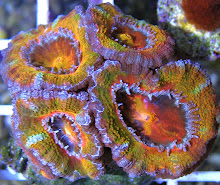Well ORA has done it again, and after much rumored speculation, the nearly all white "Platinum Perculas" have been released on a very limited basis. These fish will make any collector drool.
Heres what ORA has to say about these beauties:
Platinum Percula
"This month we are introducing one of the most eagerly anticipated new strains of clownfish ever developed at ORA™. The Platinum Percula is a nearly all white variation of the True Percula Clownfish. The result of years of selective breeding, the Platinum Percula is derived from our famous Picasso Clownfish. This striking white clownfish develops orange and then black fins as it matures, and retains some orange color in the face.Not to be confused with the Snowflake Clownfish, which is actually A. ocellaris, the Platinum Percula shows none of the original stripes characteristic of the species. While the middle stripe of the Snowflake is wide and has jagged edges, the Platinum Percula is continuously white from head to tail. No other clownfish, from the wild or from breeders, has ever come close to appearance of the Platinum Percula.
This is the rarest of any clownfish color morph ever developed, and it will be the ultimate prize for any serious clownfish connoisseur. While experimenting with pairing new Picassos, even the breeders at ORA™ were surprised to find this extraordinary result.
 As the juveniles began to grow-out we noticed the development of black fins on the rapid growers. At first the dorsal, pectoral, ventral and caudal fins appeared to be clear with some orange color. Then some black pigment appeared on the fins, as true perculas typically do produce more black color as they age. Finally we observed the full black fin color develop, and nothing looked more astonishing than black fins on a white clownfish. These fish will be shipped as juveniles with very little fin color, but expect to observe the full color develop over time."
As the juveniles began to grow-out we noticed the development of black fins on the rapid growers. At first the dorsal, pectoral, ventral and caudal fins appeared to be clear with some orange color. Then some black pigment appeared on the fins, as true perculas typically do produce more black color as they age. Finally we observed the full black fin color develop, and nothing looked more astonishing than black fins on a white clownfish. These fish will be shipped as juveniles with very little fin color, but expect to observe the full color develop over time."These fish should be arriving next week along with Naked Clowns, Picassos, And possibly some Snowflakes. We will be receiving a fresh batch of all of the great ORA frags including the new Purple Nana, and the New blue Chalice:
"We are very excited to release the Blue Chalice coral, Echinopora lamellosa. This coral has a
 beautiful plating, wavy growth form that is similar to Montipora capricornis. Under natural sunlight this coral is a pinkish tan color but under higher Kelvin metal halide or T5 lights it will turn a beautiful lavender to baby blue color. Our broodstock for this coral came from two sources back in 2002. Some was from a German hobbyist who stated the coral was originally collected in 1989, the rest was from a hobbyist named Randy Donowitz"
beautiful plating, wavy growth form that is similar to Montipora capricornis. Under natural sunlight this coral is a pinkish tan color but under higher Kelvin metal halide or T5 lights it will turn a beautiful lavender to baby blue color. Our broodstock for this coral came from two sources back in 2002. Some was from a German hobbyist who stated the coral was originally collected in 1989, the rest was from a hobbyist named Randy Donowitz"If you are interested in any of these new products, be sure to contact us ASAP, as they are sure to go fast. Availability will be on a first come, first serve basis.
You can Call us at (951)727-8332 or email us at: themysticreef@hotmail.com or sales@themysticreef.com.
Happy ReeFiNg!!








